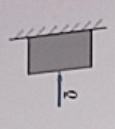物块重W=50 N,在水平力Q作用下静止。物块与铅锤墙面间的静摩擦因数f=0.2。若垂直于物块的压力Q=300 N,则物块与墙面之间的摩擦力的大小为( )The mass weighs W 50 N and remains stationary under a horizontal force Q . The staticricon coefficient f 1 s 0.2 between the block and the wall . If the pressure Q perpendicular to the block is 300 N the magnitude of the frictional force between the block and the wall is( )A.60NB.10NC.40ND.50N
物块重W=50 N,在水平力Q作用下静止。物块与铅锤墙面间的静摩擦因数f=0.2。若垂直于物块的压力Q=300 N,则物块与墙面之间的摩擦力的大小为( )
The mass weighs W 50 N and remains stationary under a horizontal force Q . The staticricon coefficient f 1 s 0.2 between the block and the wall . If the pressure Q perpendicular to the block is 300 N the magnitude of the frictional force between the block and the wall is( )
A.60N
B.10N
C.40N
D.50N

题目解答
答案
∵物体在水平力Q作用下静止,物体处于平衡状态,
∴物体竖直方向上受到的重力和摩擦力是一对平衡力
∵重力是50N,方向竖直向下
∴摩擦力也是50N,方向竖直向上
∴D正确
解析
考查要点:本题主要考查静摩擦力的计算及物体平衡条件的应用。
解题核心思路:物块静止时处于平衡状态,竖直方向的静摩擦力需与重力平衡。
关键点:
- 静摩擦力的大小由平衡条件决定,而非直接由最大静摩擦力公式计算;
- 当实际所需摩擦力小于最大静摩擦力时,静摩擦力等于所受外力(如重力)。
物块在水平力$Q$作用下静止,说明其处于平衡状态。
-
竖直方向受力分析:
物块受竖直向下的重力$W=50\ \text{N}$,墙面施加的静摩擦力$f$方向竖直向上。
根据平衡条件,竖直方向合力为零,故静摩擦力大小等于重力:
$f = W = 50\ \text{N}.$ -
最大静摩擦力验证:
最大静摩擦力为$f_{\text{max}} = \mu Q = 0.2 \times 300\ \text{N} = 60\ \text{N}$。
由于实际所需静摩擦力$50\ \text{N} < 60\ \text{N}$,满足静摩擦力未达到最大值,符合题意。